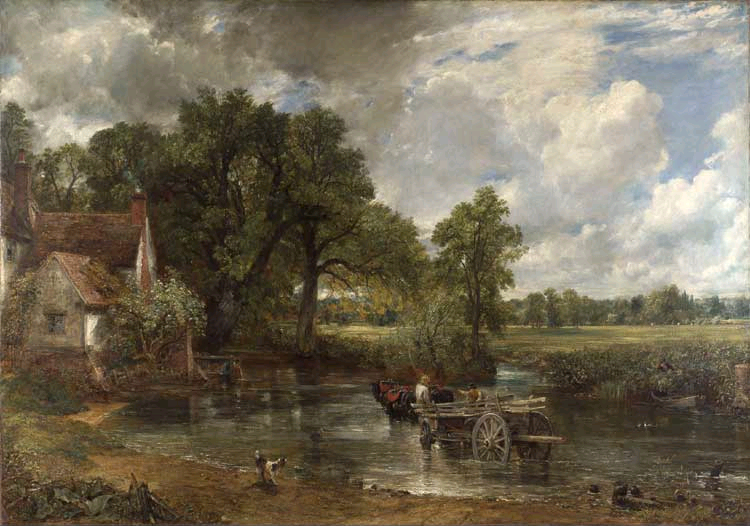A nineteenth-century English idyll: Hermits and haywains.
Listen up, ladies -- I have a most interesting tale for your consideration! If you love the works of Jane Austen, with their romantic portrayal of the aristocracy of early nineteenth-century England, this post is for you.
Once upon a time, there was a king of Britain named George III. Perhaps you know him. He was the man that perennial Cabinet favorite George Washington personally bested in a game of nine pins in the gardens of Versailles to gain the naming rights to forty-three-per-cent of the taverns, alehouses, wayside inns, public houses, and ordinaries in the American colonies. A master of wizardry, he used his comprehensive knowledge of spells to transmogrify famed Prussian monarch (and George's cousin) Friedrich der Große into an oak tree. He had never forgiven Fred, who, in a spell of religious zealotry, had struck George with a cane and spat in his wife Charlotte's (admittedly plain) face at a fete in 1788.
In addition to his regal duties, George served as headmaster of the newly-established Royal Academy of Witchcraft and Wizardry
George had a son, also named George, that fettered away his time instead of apprenticing to his father in the noble arts of magick, proving a große disappointment to just about everyone. Yet the Prince did excel in one thing: lavish hedonism! Also, he was mildly satisfactory at serving as Prince Regent for his father, a position he accepted after the House of Commons declared the King's spell-casting too out of control for a ruling sovereign, following a notorious incident where an annoyed George briefly turned William Wilburforce and Odullah Equiano into Cat-holics.
Contrary to popular opinion, dancing masters make poor hermits.
But what does this have to do with hermits, you might be asking? Did George III summon an army of his loyal servants, the hermits, to reclaim his lost crown from the Prince Regent, only to find that most hermits would rather live on a stone pillar in the baking heat of the desert rather than cooperate with their fellows? Although that would make for an exciting blog entry, and, in fact, almost did come to pass, I'm afraid that I made it up. But the Hanoverians and hermits are indeed connected, I assure you!
Let us return to that hedonistic fop, the Prince Regent George. His unfettered lifestyle inspired other romantic types to similarly indulge themselves and long to become syphilitic and/or consumptive. The broad cultural trend of a return to nature (probably not inspired by non-exercising George) inspired the golden age of the country estate, a fancy house owned by a rich family with a bunch of servants and lots of specialized rooms. With their excess moneys,
they made what they thought to be recreations of the pastoral landscapes found at ancient Roman country villas. And what scenic vista, they reasoned, could be truly pastoral without a solitary man of the soil to complement the landscape?

A latter-day hermit.
In vain the great families of England tried to attract these grizzled loners to partake of the natural bounty that their estates offered. Many even had prefabricated hermit shacks or huts (see picture at right) installed on their lands in hopes that a roving gentleman might see them and take up residence. But the hermits, one of the first professions to unionize in the wake of the burgeoning Industrial Revolution that brought the Iron Rooster to their idyllic haunts, wanted in on the prosperity of their prospective landlords and demanded compensation. The landed gentry relented, ushering in the golden age of British hermitry.
Many of the great cultural achievements of the Regency period celebrate this renaissance of solitary living. Perhaps you remember the scene in Jane Austen's Mansfield Park when the heroin, Fanny, despairing because of Edmund's seeming involvement with Mary Crawford, runs away, only to become lost on the eponymous estate. She stumbles upon the cabin of Walter, Mansfield Park's resident hermit, and his comforting words result in a secret tryst whose vividly explicit details belong more in Austen's Harlequin series, Regency Nights. As with many of her writings, Jane based this episode on her real life experiences in rural Hampshire, during which she was romantically involved with a hermit, as profiled in a recent biopic. Many of the scenes in the film are speculative, but John Malcovich, who plays Walter, gives, in my opinion, a barbaric yawp of a performance.
But what did these ensconced misanthropes do with their time, and how did they interact with the family that resided on the estate? Why did these hermits seemingly "sell out" to "the man"? And what does all this have to do with the enclosure system? Only a return visit to the Cabinet, or an unnecessarily lengthy discussion with George III's portrait, will yield semi-satisfactory answers to these questions! Until next time, the Cabinet, like my mind, is closed.




No comments:
Post a Comment